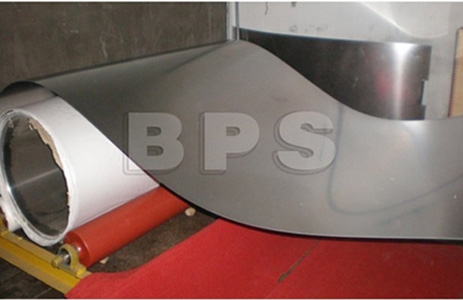 |
The BPS-SB-1320C carbon belt grade is made of hardened and tempered steel and is characterized by:
● Very good static strength
● Very good fatigue strength
● Very good thermal properties
● Excellent wear resistance
● Good weld ability
BPS-SB-1320C is a carbon steel with a hard, smooth surface and a dark oxide layer, which makes it suitable for any application with a low risk for corrosion. Very good thermal properties make it ideal for baking and for heating and drying of liquids, pastes and fine-grained products.
Chemical Composition (Nominal)%
| C |
Si |
Mn |
Al |
| 0.1-0.3 |
0.4-0.6 |
1.5 |
0.02 | Specification
Forms of Supply
The belts are, as standard, delivered in a hardened and tempered condition and have well-rounded edges. If required practically any surface finish can be supplied. Perforated belts are also available.The belts are leveled and straightened to obtain optimal flatness and straightness. The belts can be supplied in open lengths, with the ends prepared for welding or riveting on site, or in endless condition with a welded joint
Mechanical properties Static strengthStatic strength
| Standard strength at room temperature, nominal values |
| positio |
Proportional
limit |
Yield
strength |
Tensile
strength |
Elongation
A5 (%) |
Weld factor
Rm/Rm |
Hardness
HV5 |
|
|
MPa Ksi |
MPa Ksi |
MPa Ksi |
|
|
|
| Parent material |
1200 174 |
1280 186 |
11 |
|
400 |
Transverse weld
(not heat treated) |
880 128 |
990 144 |
3 |
0.77 |
|
| *See figure on page 2. |
|
|
|
|
| temperature |
Proportional
limit |
Yield
strength |
Tensile
strength |
Elongation
A5 (%) |
Weld factor
Rm/Rm |
Hardness
HV5 |
| ℃ ℉ |
MPa Ksi |
MPa Ksi |
MPa Ksi |
|
|
|
| 100 212 |
|
980 142 |
1220 177 |
10 |
|
|
| 200 392 |
|
950 138 |
1210 175 |
12 |
|
|
| 300 572 |
|
890 129 |
1170 170 |
28 |
|
|
| 400 752 |
|
720 104 |
850 123 |
28 |
|
| Impact properties
This belt grade is not recommended for use at low temperature, i.e. such as in freezing operations.
Dynamic Strength
The fatigue limit is defined as the reverse bending stress at which 50%sf the test specimen withstang a mimimum of 2X106 load cycles. These values refer to 20℃ (68℉), a normal dry atmosphere and standard specimen. The fatigue limit for the parent material is approximately ± 460MPa (67ksi).
Physical properties
| Modulus of elasticity, E |
201 000 MPa |
29 100 ksi |
| Density,ρ |
7.85g/cm3 |
0.284 lb/in3 | Theraml conductivity,λ
| Temp, ℃ |
20 |
100 |
200 |
300 |
400 |
| ℉ |
68 |
212 |
392 |
572 |
752 |
| W/mK |
38 |
39 |
39 |
40 |
39 |
| Btu/ft h ℉ |
22 |
22 |
22 |
23 |
23 | Specific Heat, Cp
| Temp, ℃ |
20 |
100 |
200 |
300 |
400 |
| ℉ |
68 |
212 |
392 |
572 |
752 |
| kJ/kgK |
0.46 |
0.50 |
053 |
0.56 |
0.61 |
| Btu/lb ℉ |
0.11 |
0.12 |
0.13 |
0.13 |
0.14 | Thermal expansion, α
| Temp, ℃ |
20-100 |
20-200 |
20-300 |
20-400 |
| ℉ |
68-212 |
68-392 |
68-572 |
68-752 |
| 10-6/ ℃ |
11.1 |
12 |
12.8 |
13.5 |
| 10-6/ ℉ |
6.2 |
6.6 |
7.1 |
7.5 | Magnetic properties
| Remanence, Br |
1.55 Wb/m2 |
| Coertcive force, He |
1490 A/m |
| Max relative permeability, μr |
410 | BPS-SB-1320C has high thermal conductivity and low thermal expansion, which makes it less sensitive to buckling and thermal strain caused by uneven temperatures.
Corrosion Resistance
General corrosion
BPS-SB-1320C is, despite its oxide layer, susceptible to general corrosion in water solution, especially at low pH values. Increased temperature, flow rate, acidity and the presence of salts increase the corrosion rate. In neutral soulutions, ions such as CrO42- and NO3- have an inhibiting effect.
Pitting and crevice corrosion
Pitting and crevice corrosion attacks can occur in choride containing solutions at intermediatte pH values, where the general corrosion rate is low.
Stress corrosion cracking
BPS-SB-1320C is not susceptible to stress corrosion craching or intercrystalline corrosion attacks.
Hydrogen embrittlement
BPS-SB-1320C is susceptible to hydrogen embrittlement. If the materials exposed to possible sources of hydrogen embrittlement a special heat-treatment of the material is recommended. Contact your Biquick office for information.
Welding
Joints with very good strength and toughness can be formed in BPS-SB-1320C. A suitable fusion welding method is gas-shielded are welding, with the TIG method as first choice.A well-balanced heat-treatment must be performed in connection with the welding, to ensure the weld has good static and dynamic mechanical properties.
|
|


